With our month looking at Avengers comics officially over, we thought it might be fun to dig into that other iconic Marvel property, the X-Men. Join us for a month of X-Men related reviews and discussion.
If the nineties could be said to belong to any particular comic book franchise, they belonged to the X-Men. Marvel has done a great job collecting classic X-Men storylines in oversized hardcover, already having more than half of Chris Claremont’s very long run available in the format. Reading his work collected here, I find myself frequently conflicted – I can’t decide whether the writer was one of the best long-form storytellers in the medium, or whether he was writing by the seat of his pants. A lot of the threads he ties together might not wrap up satisfactory, but his overarching stories suggest an incredible amount of planning. As the author led the Uncanny X-Men into the nineties, the title seems almost in chaos, but the most carefully organised chaos imaginable.
There’s an argument to be made that Claremont’s entire X-Men run is one big storyline. The individual issues are single chapters in an epic story that he’s charting, with events building off themselves, hints paying off years down the line, and all sorts of grand ideas and themes visible if the reader pulls back far enough to take in all of his canvas. In a way, his run is almost too large to process like that, too filled with tiny nuance spread across over 190 individual chapters over seventeen years. “In his mind,” New York Magazine writes, “Claremont was writing the Great American Novel about complex characters who just happened to fly.” That’s not too far from the truth.
Of course, that makes navigating Claremont’s story particularly difficult, as different wheels are spinning at any different moment, and it’s hard to find a particular cut-off or jump-on point amid it all. Although this omnibus is structured relatively logically – bridging the gap between Inferno and X-Tinction Agenda – there are still on-going plots that kicked off before this collection begins (like Polaris’ arc and the “Siege Perilous”itself) and preludes to arcs to be collected at a later point (including a page here or there hinting at an upcoming Shi’ar plotline).
It does feel as if you’re jumping into the middle of an on-going story, and can be a bit disorienting at times. In fairness to Claremont, he tends to write solid exposition to introduce each plot point, so you’re never completely in the dark. Of course, this is another mixed blessing, because it also makes the collection read quite funny if you try to absorb a lot of it in a single sitting – the book wasn’t designed to be read this way, and so you get a whole page of clunky exposition explaining what you just read a moment ago. (Or even captions of Wolverine explaining his powers.) It’s not a bad thing, as it’s a whole lot more accessible than most modern comic books, but it does read funny in collected form.
I don’t think any mainstream superhero writers developed ensembles quite like Claremont, and I don’t think that any author was able to carve out such a distinguished niché for their work. In many ways, the stories collected here illustrate how the X-Men were different from any number of superhero teams. It was never about the team, or the institution, or the setting. It was about the characters. Early on in the section of his mammoth run collected here, Claremont seems to spontaneously decide to dissolve the X-Men as a team, leading to a variety of stories following the characters in their smaller and interpersonal interactions, giving us a glimpse of the sorts of lives that they might have led, had things been differently.
This isn’t a single issue. This isn’t a dream sequence. It isn’t even a six-issue arc. It’s a bold direction for the series, and one that Claremont sticks to. In many ways, this feels like an X-Men comic without the X-Men. We get an idea of what the world without these mutants might look like. As the captions remark of Rogue, “For the first time in her young life, she’s on her own.” It feels like the cast are on their own, isolated from one another. And, to Claremont’s mind, none of the cast are as strong alone as they are together. Instead, they are merely prey. A number of plotlines follow the same format, with the lone X-Men encountering a threat and proving unable to best it single-handed. It’s only through teamwork that the mutants function at all.
Perhaps it’s a sign that Claremont knows that his impressive run is coming to a close – it’s a desire to invert the formula that Len Wein used to bring together the mutants in Giant-Sized X-Men #1, all those years ago. This time, a convenient plot device seeks to break up the X-Men, rather than uniting them. He even teases this idea as he tasks two groups with “putting the band back together”, so to speak – with one issue even titled All-New, All-Different — Here We Go Again!
It’s true that some of these plotlines feel a little stale or random, or even directionless. It doesn’t help that the years have done little to temper the more wacky aspects of Claremont’s weird artistic quirks – mind control and body transformation abound through is volume. And yet, despite this, I have some measure of trust in Claremont. He’s a writer who has a knack for seeding ideas and them paying them off down the line. After all, the mysterious antagonist of this story – the Shadow King – was introduced over a decade earlier in a one-shot focused around Charles Xavier. Within the story, the character claims to have waited “a human generation” to strike, but he’s also waited ten years in real-time from his first appearance.
I don’t know if this idea was in Claremont’s head when he wrote that throw-away story with Professor X in a dingy bar, but it’s a fascinating subversion of one of the old comic book truisms, and perhaps a sign that the industry was changing more than people expected. I genuinely believe that Claremont’s true skill as a writer was his ability to be ahead of the curve, so it’s possible he detected that shift coming.
In the old days, comics used to assume that they’d cycle through a generation of youngsters in about seven years or so. As such, they’d drop old plot points and recycle old plot lines, based around the assumption that it was unlikely any of their readers would have been present for the last go-round. Claremont’s reliance on plot points originally articulated over a decade ago seems to be a strong aversion of this tendency, and perhaps an indication that comic books were holding on to their fans for longer. (The other side of the coin being that perhaps they weren’t gaining as many new ones.)
As such, Claremont’s plotting appeals to older fans, who have been reading the book for longer, at the potential cost of alienating new readers. These days, it’s common knowledge that average age of a comic book fan is much older than it would have been in the seventies, and I don’t think it’s unfair to suggest Claremont was wryly aware of such shifts. In fact, the author seems to be writing for a slightly older demographic, as judged by the constant references to Aliens.
The author’s fascination with H.R. Giger’s creation makes perfect sense. After all, they both share a creepy pseudo-sexual element, with the phallic design of the monster seeming not too far from the sexual kinks of Claremont’s Hellfire Club. In fact, both series also feature strong female heroines, with the iconic Ripley and any of the featured women in Claremont’s long run. The Brood, an earlier creation of Claremont’s, seem inspired by Giger’s monster, and this volume contains a large number of references. “Hey, Sarge,” one bad guy taunts, “maybe it’s the ‘Alien’?” Jubilee thinks at one point, “So maybe I’m not Sigourney Weaver, so sue me!” Indeed, my favourite reference has Storm, in a mechanic suit, challenging, “Get away from him, you murdering old witch!”
There are other esoteric pop culture references, and it’s telling how in-tune Claremont was with the counter-culture geek mindset. His references, for example, to Doctor Who are probably easier for fans to spot now than they were when originally published. At the time, the old series was on the verge of dying, so I wonder how many American fans would have noted the use of “Brigadier Alysande Stuart” (as opposed to Brigadier Alistair Lethbridge-Stewart) as part of the conspicuously-named “Weird Happenings Organisation.” Given the success of the relaunch, it seems more likely that old fans will pick up on a reference they would have missed the first time around.
However, Claremont is also shrewdly aware of developments within comic books themselves. It seems that his writing here is heavily influenced by both Watchmen and by The Dark Knight Returns. A non-copyright-infringing variation on the iconic Watchmen smiley-face can be glimpsed in more than a few panels, while Claremont seems to write a significant portion of this collection (and some of the stronger issues) as an outright homage to his former collaborator, Frank Miller.
Indeed, the character of Jubilee seems like an affectionate homage to the female Robin, Carrie, that Miller created for The Dark Knight Returns. With her green shorts and red t-shirt (with a yellow coat instead of a yellow cape), the reference seems increasingly obvious, especially when other characters refer to her as “the Canuck’s new sidekick!” As if the analogy wasn’t strong enough, Claremont even asks us to imagine Wolverine as his counterpart to Batman, taking the opportunity to have more than a few laughs at the expense of Burton’s Batman adaptation. “Tell me, bub,” he taunts the Mandarin at one point, “you ever dance with the devil by the pale moonlight?” (Asked what it means, he replies, “Beats me.”)
Indeed, it seems like Claremont is also drawing heavily from Frank Miller’s celebrated Daredevil run. When the Hand kidnap Psylocke, they vow, “If we can turn her, Lord — succeed where we failed with Elektra — then truly nothing is beyond our power!” Even his crossover with Captain America, the celebrated Madripoor Knights, draws upon the history of Black Widow with the Hand, as covered by the last Frank Miller arc on Daredevil.
A lot of people would argue that Claremont effectively isolated his X-Men from standard Marvel continuity, but I’d suggest that he always made his influences quite clear. It’s easy to judge the writers and runs that the author admired, if only because he tended to reference of incorporate them into his Uncanny X-Men run. After all, The Asgardian Wars reads like a tribute to Walt Simonson’s Thor, and his Lady Mandarin trilogy feels like an homage to Miller’s Daredevil.
I’d argue that the trilogy of issues represent some of the best work that Claremont did at this stage of his writing on Uncanny X-Men, and illustrates the best way to do a tie-in. The three-part arc is a tie-in to the Acts of Vengeance crossover that took place, pitting various Marvel heroes against some unexpected villains, and I think that Claremont manages to tell his own story, without being bound to another, and still hits on all the key thematic points. I think it stands as a great story in its own right, while filling the criteria of a tie-in, which is perhaps the very definition of success. You can read this story without any idea about Loki’s evil scheme, and it still seems like a complete story.
I think that the Lady Madarin arc works so well is because it plays out a lot of Claremont’s ideas in a microcosm. It’s about power, which arguably all of Claremont’s writing is – it’s about giving power and taking power. It’s also about feminism, as Betty reflects on her past. “Why was Brian chosen to become Captain Britain, and not me?”she wonders, and the answer seems self-evident: because she’s a girl, and he was a boy. The arc sees Psylocke, the team’s butterfly-themed psychic, transformed into a glorified sex object. It’s telling that she spends the first half of the collection in some of the most practical body armour that I’ve seen a superheroine wear, before she is suddenly brainwashed and put into little more than a thong.
Claremont writes very strong women – I think that Storm deserves recognition as one of the earliest strongest female superheroes – and here he focuses on the idea that objectifying them removes their power. The villainous Masque attacks Callisto by making her look beautiful, “Because you’re strong and tough and smart — c’mon baby work for me — and the way I can hurt you best — little more little more that’s the spirit –is by taking all that away from you.” Callisto tries to explain her frustrations to Peter, “All I am anymore, Peter, is a package.” The Hand do something very similar to Psylocke, altering her appearance and having her prance around nearly naked, altering the character’s identity and taking away part of herself.
Of course, the net impact of these changes has led to two decades of an identity crisis for the character, who has really struggled to find her place. It’s a bit of a tragedy, to be honest, as the physical transformation was intended to illustrate how brutal the assault on her psyche had been. It’s easy to lose sight of these thematic elements when Claremont throws crazy ideas like “Asian ninja Psylocke!” and “child Storm!” and “evil robot nanny!” at us every few issues, but I think that there’s a strong connection to be made between some of the kinkier elements of Claremont’s storylines and the powerful underlying themes of the X-Men.
It seems that you can’t flip more than five or ten pages without encountering some form of mind-control or body transformation. Storm is turned into a child. The Shadow King turns humans into his “beasts.” Hell, the Shadow King manifests himself in another’s flesh. Worm coats people with his “goo” and forced them to do his will. Masque moulds his prey like paper mache. Psylocke is brainwashed and transformed. All the X-Men have their memories wiped. It might seem a bit strange to tie these elements into an on-going series about civil rights, but I think Claremont manages to do it.
The X-Men are fundamentally about freedom, and freedom is anchored in trust and control – the X-Men are victims of a societal prejudice and institutional racism, with little control over their own rights or destinies. Claremont’s themes play into that – the lack of control they exert over their own lives is reflected through the lack of control that his characters demonstrate over their own bodies and their own actions. The “bondage” theme of the Hellfire Club even seems to play into the idea of “human bondage”, manifesting itself through creepy pseudo-sexual imagery.
Eureka! Of course that’s it! I’m not reading too much into the mildly unsettling S & M subtext of the comic, Claremont’s sexual politics are clearly just a sexual metaphor for politics! The relationship between the individual and the state is clearly reflected in Claremont’s recurring bondage imagery – the idea of surrendering power over yourself, and trusting somebody else to wield that responsibly. I wonder if the relative overabundance of lingerie and corsets, even by the standards of superhero comics, was part of what helped Uncanny X-Men appeal to readers, as a title with a very definite “edge.” However, I think I’ve figured out why that works so well in the context of this comic book. (While it would, for example, stand out like a sore thumb in Spider-Man or Captain America.)
While it doesn’t, for example, quite justify some of the more gratuitous elements. Indeed, I’m not quite sure why Psylocke still continues to wear a glorified swimsuit after she’s been restored to her old personality, or why the complete extreme makeover doesn’t seem to be a big deal to her. Given the tendency of later writers and artists to objectify Psylocke, I wonder if Claremont missed an opportunity to clarify what he was going for here. Still, I think it works in this context.
“I will not be bound!” Storm vows, at one point. “I will not be enslaved!! Whatever the cost — I shall be free!” While he occasionally hammers the point a little too hard, his use of these sorts of storytelling techniques do resonate with the underlying theme. His female characters worry about objectification, as an expression of the latent sexism that they face on top of the anti-mutant prejudice. Just as Claremont used that prejudice as a framework to create one of the most ethnically-diverse teams in comic books, he also deals with other forms of prejudice and control and restraint.
Claremont seems to be moving with the times – not only in terms of the real world, but also in terms of the fictional Marvel Universe. Writers far smarter than myself have commented on a cosmic shift within the marvel universe between its early days and its present – changing its heroes from a bunch of down-and-outers to something akin to an elite over-class. Claremont’s writing here almost seems to foreshadow that shift in perspective and portrayal. Indeed, it seems that mutants are almost on the cusp of acceptance – and that the only alienation they seem to feel from the general public is that which separates conventional heroes.
After years of protecting a world that hates and fears them, the younger characters in Claremont’s Uncanny X-Men begin to accept the mutants, leaving the pure and bitter hatred to monsters like Donald Pierce and his Reavers. “Man was created in God’s image, lad,” he suggests, falling back on religious rhetoric to justify irrational hatred and fear. “Those creatures — even those who pass for human — are but the grossest, foulest abomination.” It’s an irony coming from a man who transformed himself into a monster to fight them.
In contrast, the very first issue collected here introduces the character of Jubilee, and the reaction towards her is telling. “Bet she’s a mutie!” one kid chides. “Who cares, barf-butt! She’s neat!”another retorts. It seems like the pendulum is swinging, that mutants might be slowly eroding some of the prejudices, perhaps standing in for any of the cool counter-cultures that emerged during the seventies and eighties. It’s fascinating that Claremont wrote the title for seventeen years, and yet avoided a comfortable status quo. While his plot developments weren’t always organic, there was a sense that things were subject to change.
In fact, it seems that the public in Claremont’s epic are growing increasingly unsatisfied with the mutant population because the merry mutants are living a life that’s too perfect. “We’re just ordinary folks, hon,” one passer-by remarks, looking at the X-Factor headquarters. “What do those high-an’-mighty muties know about people like us? Or care?!” It’s a thoughtful sentiment, as the heroes of the Marvel Universe seem to increasingly isolate themselves from the general population. “Look at us now,” Jean remarks, “living in our own private world, totally divorced from the greater one around us.” I quite like that line, because it suggests that the mutants are both disconnected from the ordinary citizens and from Marvel Universe itself, a comment on how the franchise had grown a continuity of its own.
Indeed, Beast accurately comments how this question of relatability isn’t necessarily restricted to Claremont’s X-Men. “We’re not the only ones facing that conundrum, Jean — the Avengers have their mansions, the Fantastic Four have their own skyscraper. Perhaps, for better or worse, the isolation comes with the territory.” And Beast sound know. He’s been an Avenger himself. You could argue that the whole point of the Siege Perilous arc is to put the X-Men “back in the world”, so to speak – to allow them to have new adventures outside the existing and established framework. Storm’s adventure in particular seems to almost give her a second origin story, “Different details. Same essence.”
I also like Claremont’s attempt to shift away from “the Children of the Atom.” Stan Lee invented the mutants at about the same time that he created many of Marvel’s more iconic superheroes, and they were all introduced in the shadow of the atomic bomb. It’s a premise that made them all relatively timely, but the world changes. When Marvel published Ultimate Spider-Man in 2000, they updated the spider that bit Peter Parker from “radioactive” to “genetically-modified.” Sure, it doesn’t work quite as well in the theme song, but it feels more up-to-date.
It seems like Claremont tries something similar here, even if he never directly states it – the idea of biological warfare, and the ever-expanding scientific exploration of the human genome. “In the coming era,” Soviet spymaster Vazhin states, “with the splintering of the established world order and the possible dismantling of strategic nuclear stockpiles… there’ll be greater impact in their biological counterparts. Who needs a nuke… when there’s a Havok? Or a Thor?” Sure, it’s not quite as succinct as Mark Millar’s Ultimates, but it’s quite a prescient observation.
Indeed, there’s also an observation that almost hints at the cynical deconstruction of superheroes that we’d see in the post-Watchmen era, leading to events like Marvel’s Civil War. “In the past, the super heroes somehow enforced a code of conduct that prevented things from getting out of hand,” Colonel Alexei Vazhin explains. “But that old order is breaking down.” Claremont seems finely-tuned to the fact that this is a changing world for the established superheroes. “I fear this is a new game, Doctor Cooper. With no rules at all.” Claremont build the success of Uncanny X-Men around the fact his stories were timely and relevent within the medium, offering something a bit edgier than the already-established Fantastic Four or Spider-Man. There’s no indication that Claremont has slipped out of touch.
In fairness, there are signs that Claremont is feeling a little bit tired, and that he’s easing off the narrative throttle. Following on from the massive crossover (or, if you will, X-over) Inferno, the collection opens with two done-in-one stories based around two nights that the boys and girls on the team take off, as a means of letting off steam. In fairness, I chuckled at the “Jean Bomb”bit, and it’s nice to see Claremont remains wryly aware of his own artistic quirks and tics.
More than that, though, the dissolution of the team seems rather forced, with a minimum amount of foreshadowing. It just sort happens, presumably because Claremont wanted to tell a particular type of story. Similarly, Longshot’s departure from the team seems almost random. In fairness, Havok gives a pretty good justification:
“How can we even call ourselves a team anymore, just the four of us left, living out in the middle of nowhere, what good are we to anyone? How does this further Professor Xavier’s dream — remember, the one that brought us all together — of a better world, where mutant and human can live together in peace? Listen to me — “mutant and human” — as though being the one precluded the other. It’s like we perpetuate the prejudice, even as we try to fight it. Well, I’ve had it folks. I’ve paid my dues — we all have, with the scars to prove it. I say it’s time to call it quits!”
Of course, this ignores the fact that Xavier’s exclusively mutant school hardly fostered integration, but the bigger problem is that it comes out of nowhere. It’s not as if there isn’t reason to doubt their mission – Storm had “died” only a few issues earlier, and the team didn’t seem to settle into their new Australian status quo particularly well. However, Claremont fails to make this add up, so it comes out of nowhere.
That said, I am quite fond the suggestion Claremont makes that the team suffered from the lack of an anchor – illustrating that Storm and Wolverine are very much the heart of his extended run on the title. Indeed, Wolverine seems to suggest that he would never have allowed the team to dissolve had he been present. As his illusion of Kitty taunts, “Maybe if you’d been here, Wolvie, you could’ve argued against it.”
I’ve found Wolverine’s development under Claremont fascinating, as he portrays the character as a strange hybrid of lone gunslinger and solitary samurai, with a man devoted to an idea. There’s a sense that, more than even the original students, Wolverine has been changed and improved by Professor Xavier’s dream. The growth is illustrated by the conversation he has with a hallucination of Nick Fury, who remarks, “You can’t kill everybody, pal.” Wolverine concedes, “Sure worked for me, bub… till I signed on with the X-Men.”
That said, there is a sense that there’s only so far Claremont can push these characters. Indeed, Magneto only appears periodically in the collection, but Miora explicitly suggests that he’s reached the climax of his character arc, and there’s nowhere else for the character to go. “What comes next, O Master of Magnetism,” Moira MacTaggert taunts him, “another Brotherhood of Evil Mutants?” This is exactly the sort of cycle that Morrison’s New X-Men sought to wrap up once-and-for-all. Even veteran members of his heroic teams seem to be a little worn out. Masque’s Jean Grey monster asks Forge, “Will it never end?” That’s the tragedy of a continuing long-form narrative like this, that Claremont’s story will never have a conclusive ending.
Claremont compensates, as usual, by introducing new characters. Here he gives us characters like Jubilee and Gambit, as well as developing background on Forge’s character. I have a fondness for Claremont’s character work, and I do quite like the way he focuses on Forge’s background, in particular his time served in Vietnam. Indeed, it’s worrying that the only other comic-book Vietnam veteran I can think of is the Punisher, and it’s nice to see that a veteran can be handled with respect – that he doesn’t need to come back unable to process the horror. I do think that Claremont had a wonderful capacity for generating interesting characters, who were far from your generic cardboard superheroes.
In the context of this new generation, it’s worth considering that two-part story which sees Forge confronting Masque and his mutants. This falls back on the old Claremont plot-device of pitting the team against its earlier incarnations. In his first few issues, Claremont would typically set his “all-new” X-Men against Stan Lee’s classic line-up. Never the real deal, always robots or illusions, but a symbolic conflict between the new guard and the old guard. It’s telling that Forge and Jean find themselves confronting Claremont’s “all-new” generation, including Storm and Wolverine. It’s a nice acknowledgement of how time has moved on, and how Claremont’s original line-up are no longer the “outsiders”, but what the public thinks of when they hear the name “X-Men.” In essence, his later incarnations of the team are no longer measured against the work of Stan Lee, but against Claremont himself. I’m glad that he recognised that.
Speaking of the outside perception of the X-Men, you can see the franchise just about to take off. The nineties were a great era for the X-Men, as they launched their own cartoon and seemed to be the biggest thing at Marvel. They seemed to have the capacity to just generate fantastic and iconic artists. Here, you can see the first hints developing, including the iconic blue-and-gold outfits. “I hate to sound ungrateful, guys… but is this what passes for X-Men uniforms these days?” Jean asks in the form-fitting spandex, that would define the line-up into the nineties.
I find it fascinating that Claremont was allowed to push such a diverse group of mutants, but that he wasn’t allowed to make Mystique explicitly lesbian. Still, a reference slips through when the Shadow King refers to “Mystique and her leman, the precognitive Destiny.” “Leman” is apparently an archaic word for “lover.” Indeed, I always got the sense that Claremont was never allowed to go as far as he might have wanted with Mystique.
Indeed, he originally wanted her to be Nightcrawler’s father, which would have opened up all sorts of interesting questions, particularly around how gender identity applies to shapeshifters. Given how the X-Men books value diversity, and how much of their appeal arguably stemmed from that diversity, I find it disappointing (if not wholly surprising) that Claremont was never allowed to develop that plotline. Gay and transgender rights were really just emerging as a political issue in the eighties, and are still hugely topical today. Perhaps somethings were tootopical for Marvel’s editorial.
The artwork for the collection is awesome. Uncanny X-Men had a reputation for producing the best artistic talent in the business – John Byrne, John Romita Jr. – and it continues here. Although Jim Lee appears to be the main selling point of the collection, Marc Silvestri is actually the artist for most of the issues, which is quite an accomplishment when the book was shipping twice-a-month. It looks great, and I think I actually prefer Silvestri’s art here to that from Lee. Of course, Lee does provide some of the better-written issues in the collection, including the aforementioned Lady Mandarin trilogy and the iconic Madripoor Knights, which set the stage for any number of flashback Wolverine stories.
This isn’t Claremont at his best. This isn’t the most consistent collection of Uncanny X-Men that you are ever going to read. It’s very uneven and more than a little surreal at times. However, it does have a lot of interesting ideas going on, and I think it illustrates that Claremont was more than willing to take creative risks with the title. There are a few genuine classics to be found between the pages. Sure, there’s a lot of other strange stuff going on to, but I admire Claremont’s willingness to push the title in strange and new directions, even if it doesn’t quite succeed.
You might be interested in or reviews of some of the rest of Chris Claremont’s Uncanny X-Men run (and other assorted mutant-related work):
- Uncanny X-Men by Chris Claremont, Vol. I
- The Dark Phoenix Saga
- Asgardian Wars
- The Mutant Massacre
- Inferno
- Fall of the Mutants
- X-Men by Chris Claremont and Jim Lee (and Marc Silvestri), Vol. I
- X-Tinction Agenda
- X-Men by Chris Claremont and Jim Lee (and Marc Whilce Portacio), Vol. II
Filed under: Comics | Tagged: arts, Captain Britain, chris claremont, Claremont, dark knight returns, Havok, Jean Grey, jim lee, Len Wein, Marc Silvestri, marvel, marvel comics, Moira MacTaggert, Professor X, Shadow King, Siege Perilous, sigourney weaver, uncanny x-men, wolverine, x-men, X-Tinction Agenda |















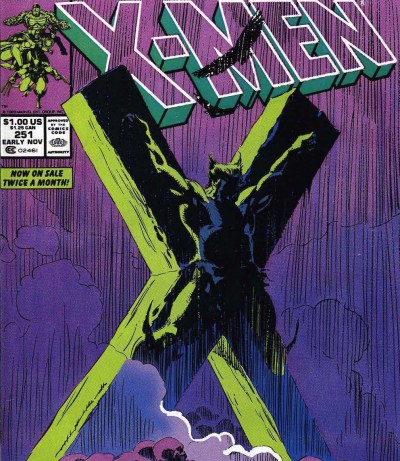

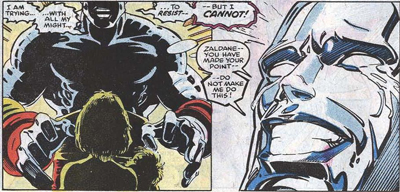
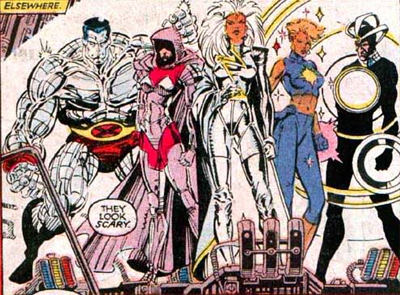
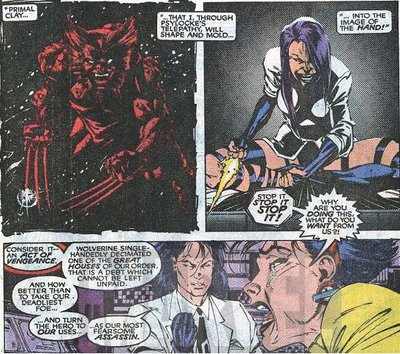



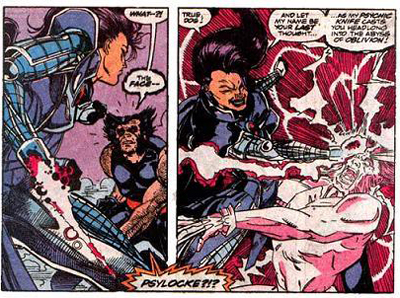
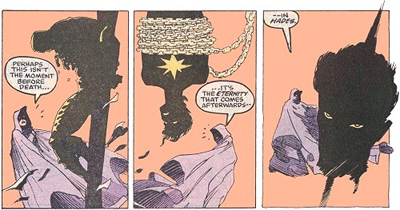


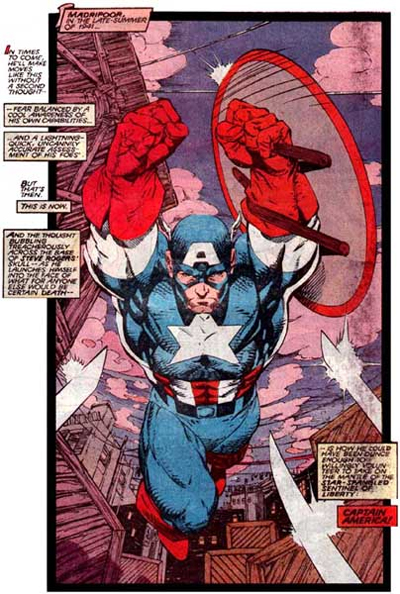
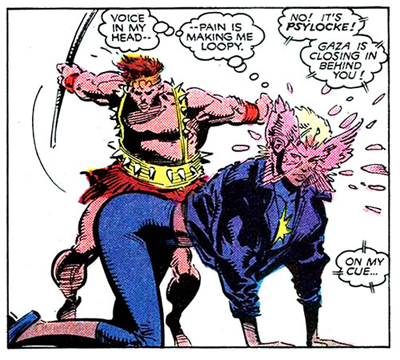

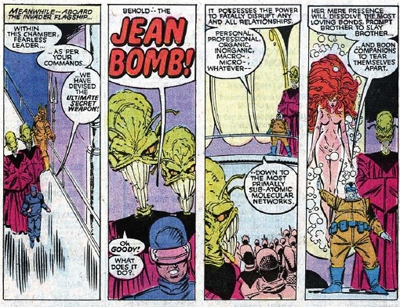












I was looking at the covers and it made me go over my X-Men collection and I realized how good Jim Lee’s art was before he did the 2nd X-Men series (when his art got looser and he used cross-hatching to cover-up for lack of detail) and WildCATS. It’s funny but the way he rendered back then, with more texture and moodier tones looks a lot better than his Hush work and somewhat resembles the better moments from his All-Star Batman work. I don’t know about everyone else but his older stuff looks even more “current” than his older stuff — sort of in the same way that Neal Adams’ older Batman work looks better than his art these days. With Adams, it’s understandable — he’s older and his hands are probably shakier. With Lee, I’m not sure what’s happened. Maybe he isn’t challenged anymore.
I think that’s it – although I suspect it’s also his elevation to the highest echelons of comic book artistry. His work was always more static than dynamic, but his more modern work looks like a collection of pin-ups. That said, wonderful, detailed, iconic pin-ups, but really sort of lacking that panel-to-panel sense of movement. Although, I think the colouring on his adjectiveless X-Men run did diminish it a bit – I’m actually thinking of double-dipping on Mutant Genesis 2.0. I try to justify to myself that it’s because I (honestly and controversially) consider it one of Claremont’s stronger stories*.
* okay, it doesn’t measure up against God Lives, Man Kills, Dark Phoenix, Days of Future Past, I, Magneto or any of those bona fides classics. But, as a stand-alone epilogue to an iconic run, I do think it’s about as good as the Mutant Massacre.